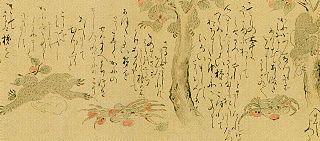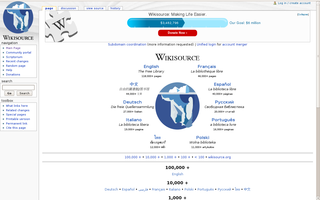Japanese folktales are an important cultural aspect of Japan. In commonplace usage, they signify a certain set of well-known classic tales, with a vague distinction of whether they fit the rigorous definition of folktale or not. The admixed imposters are literate written pieces, dating back to the Muromachi period or even earlier times in the Middle Ages. These would not normally qualify as "folktales".

The revenge of the forty-seven rōnin, also known as the Akō incident or Akō vendetta, is an 18th-century historical event in Japan in which a band of rōnin avenged the death of their master. The incident has since become legendary.

Algernon Bertram Freeman-Mitford, 1st Baron Redesdale, was a British diplomat, collector and writer. Nicknamed "Barty", he was the paternal grandfather of the Mitford sisters.

Bunbuku Chagama is a Japanese folktale about a raccoon dog, or tanuki, that uses its shapeshifting powers to reward its rescuer for his kindness.
Konohanasakuya-hime or Konohananosakuya-hime, in Japanese mythology, is the blossom-princess and symbol of delicate earthly life. She is the daughter of the mountain god Ohoyamatsumi. She is often considered an avatar of Japanese life, especially since her symbol is the sakura. Konohanasakuya-hime is also the goddess of Mount Fuji and all volcanoes.

The Langs' Fairy Books are a series of 25 collections of true and fictional stories for children published between 1889 and 1913. The best known books of the series are the 12 collections of fairy tales also known as Andrew Lang's "Coloured" Fairy Books or Andrew Lang's Fairy Books of Many Colors. In all, the volumes feature 798 stories, besides the 153 poems in The Blue Poetry Book.

"Bearskin" is a fairy tale collected by the Brothers Grimm, as tale no. 101. A variant from Sicily, Don Giovanni de la Fortuna, was collected by Laura Gonzenbach in Sicilianische Märchen and included by Andrew Lang in The Pink Fairy Book. Italo Calvino included another Italian version, The Devil's Breeches from Bologna, in his Italian Folktales.

Shita-kiri Suzume, translated literally into "Tongue-Cut Sparrow", is a traditional Japanese fable telling of a kind old man, his avaricious wife and an injured sparrow. The story explores the effects of greed, friendship and jealousy on the characters.
The Gold-Children is a German fairy tale collected by the Brothers Grimm, tale number 85. It is Aarne-Thompson type 555, the fisherman and his wife, followed by type 303, blood brothers.
The Grateful Beasts is a Hungarian fairy tale collected by Hermann Kletke. Andrew Lang included it in The Yellow Fairy Book.

Floral Magician Mary Bell, or known as Magical Heroes in some countries, is the fourth and last magical girl anime by Ashi Productions. The fifty-episode series first aired in Japan from 1992 until 1993. It has also been broadcast in Hong Kong, South Korea, Italy, Taiwan, China, France, Poland, Thailand, and in most Arab countries. The series was adapted as a theatrical film and two educational films. The DVD version was released on March 20, 2004.
The One-Handed Girl is a Swahili fairy tale, collected by Edward Steere in Swahili Tales. Andrew Lang included it in The Lilac Fairy Book.

The Crab and the Monkey, also known as Monkey-Crab Battle or The Quarrel of the Monkey and the Crab, is a Japanese folktale. In the story, a sly monkey kills a crab, and is later killed in revenge by the crab's offspring. Retributive justice is the main theme of the story.
"The Little Girl Sold with the Pears" is an Italian fairy tale collected by Italo Calvino in Italian Folktales, from Piedmont. Ruth Manning-Sanders included a variant, as "The Girl in the Basket", in A Book of Ogres and Trolls.
Tales of Old Japan (1871) is an anthology of short stories compiled by Algernon Bertram Freeman-Mitford, Lord Redesdale, writing under the better known name of A.B. Mitford. These stories focus on various aspects of Japanese life before the Meiji Restoration. The book, which was written in 1871, forms an introduction to Japanese literature and culture, both through the stories, all adapted from Japanese sources, and Mitford's supplementary notes. Also included are Mitford's eyewitness accounts of a selection of Japanese rituals, ranging from harakiri (seppuku) and marriage to a selection of sermons.
The Gifts of the Magician is a Finnish fairy tale. Andrew Lang included it in The Crimson Fairy Book (1903), listing his source as Finnische Mahrchen.

Batsford Arboretum is a 55-acre (220,000 m2) arboretum and botanical garden near Batsford in Gloucestershire, England, about 1½ miles north-west of Moreton-in-Marsh. It is owned and run by the Batsford Foundation, a registered charity, and is open to the public daily throughout most of the year.

HeartCatch PreCure!, or HeartCatch Pretty Cure! is a Japanese anime series and the seventh installment in the Pretty Cure metaseries by Izumi Todo. Produced by Toei Animation, the series is directed by Tatsuya Nagamine and written by Takashi Yamada. Official character designs were done by Yoshihiko Umakoshi. The series premiered on February 7, 2010 on TV Asahi's ANN network, following Fresh Pretty Cure!, and ended on January 30, 2011, where it was followed by Suite PreCure. The series has two main motifs. One is fashion, which is referenced to Tsubomi joining the fashion club, which is part of the storyline. And second is flowers, which are prominent in the naming of numerous characters and items, as well as in the main storyline. Additionally, most episodes contain at least one reference to the language of flowers.

Seppuku, sometimes referred to as harakiri, is a form of Japanese ritual suicide by disembowelment. It was originally reserved for samurai, but was also practiced by other Japanese people later on to restore honor for themselves or for their family. A samurai practice, seppuku was used either voluntarily by samurai to die with honor rather than fall into the hands of their enemies, as a form of capital punishment for samurai who had committed serious offenses, or performed because they had brought shame to themselves. The ceremonial disembowelment, which is usually part of a more elaborate ritual and performed in front of spectators, consists of plunging a short blade, traditionally a tantō, into the belly and drawing the blade from left to right, slicing the belly open. If the cut is performed deeply enough it can sever the descending aorta, causing a rapid death by blood loss.

"Kobutori Jīsan" is a Japanese Folktale about an old man who lost his lump after joining a party of demons celebrate and dance for a night.
















